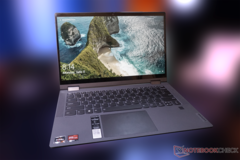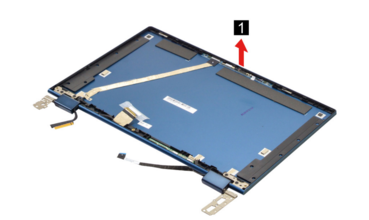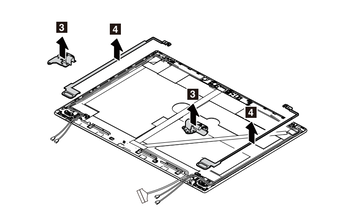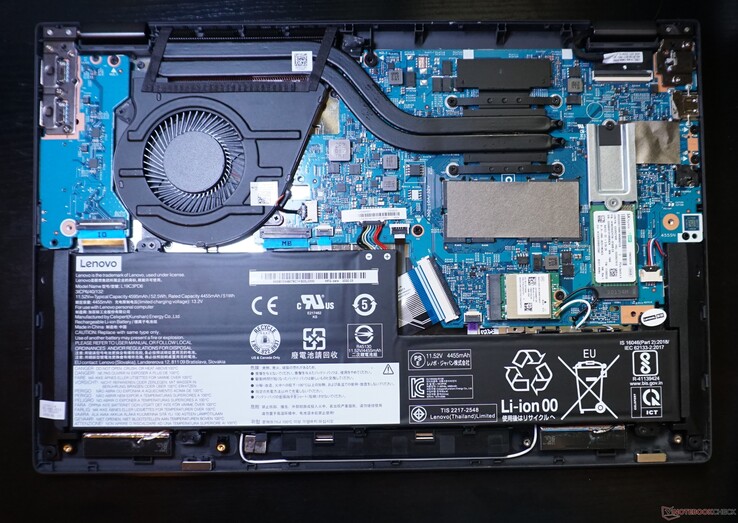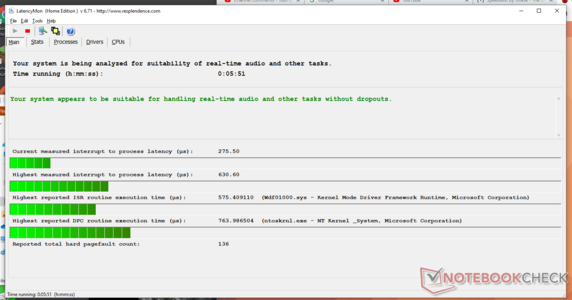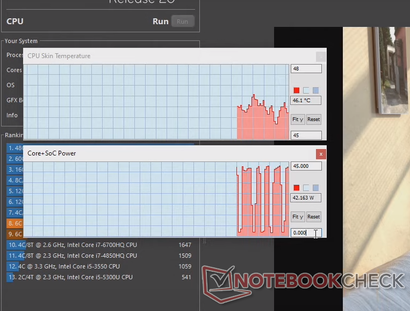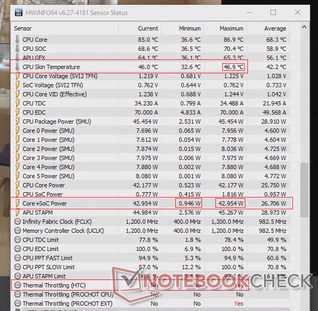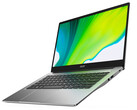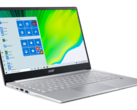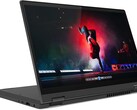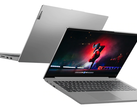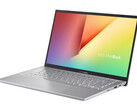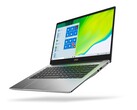It's taken some time, but budget Renoir-powered laptops are slowly reaching storefronts. Recently, Lenovo rather quietly released the Lenovo Flex 5-14ARE, a 14-inch convertible laptop running AMD's latest Ryzen processors. At only $600 on Amazon at the time of writing, this laptop is one of the cheapest Ryzen laptops you can get. The model we're taking a look at features a Ryzen 5 4500U APU paired with 16 GB of 3200 MHz DDR4 memory in a dual-channel configuration.
This isn't a review, so we won't be doing the traditional full range of tests. However, there will be performance results shown and compared with the other Ryzen-powered laptops we've taken a look at recently.
Finish and Build Quality
The finish on the lid of the Flex 5 feels rather premium. It's a smooth plastic with a matte finish, which has an almost metallic look on a desk. On the right edge, Lenovo has opted to add a metal badge with its logo. The bottom of the laptop feels slightly less smooth while being far from rough.
The keyboard deck of the laptop is a grippy, slightly rough, gray plastic. While this material doesn't feel as luxurious as the cover of the laptop does, the grip it provides while using the laptop in tablet mode seems to justify this design choice.
While holding the laptop with two hands, it doesn't feel wobbly or flexy like some laptops can. Even with the laptop open, the keyboard deck portion of the device is surprisingly rigid for being made of plastic. The only issue I've run into is some slight squeaky creaking along the left side of the device when holding it a certain way. Otherwise, the lower portion of the laptop feels rather solid.
The upper portion of the laptop feels sturdy as well. Only a few degrees of flex could be observed when trying to gently flex the lid by applying gentle pressure in opposite directions on the corners of the screen. The hinges also feel great and the lid opens with one hand easily. At around 90 degrees, the hinge becomes firm and requires two hands to fully convert the device into a tablet, but this is to be expected from a 2-in-1.
While we're on the topic of hinges, the internal design of the hinges on the Flex 5 are a bit concerning in terms of longevity. Many devices can fail at the hinges for a number of reasons, but a big reason is poor mounting.
In the Flex 5, the hinges appear to be rather small and only along the bottom of the laptop screen, focusing most of the pressure from moving the screen on that portion of the plastic. The hinges seem to be screwed into a plastic subframe going up the sides of the screen, but it's unclear if those arms would actually help bear the load. It's worth noting that the lid does not seem to flex at all while opening and closing the machine, so there isn't any sort of obvious mechanical issue.
This design choice is mildly disconcerting for anyone who wants to hold onto this laptop for an extended period of time. There haven't been any signs that the hinge design is a problem during our short time with the device, but it's something to look out for. Some folks on Lenovo's product forums claim this has been a long-term problem with Lenovo's Yoga. Since only Yogas are mentioned specifically, it's not clear if this affects the Flex 5.
If you notice any cracks forming at or around the hinges, or if it feels like the hinges are loose inside the device, it would be wise to get in touch with Lenovo before the end of your warranty period.
Notable Features
One thing this affordable 2-in-1 has that many laptops don't is a full-size SD card reader. While testing this reader out, it was capable of maxing out my 90 MB/s SD card that I had on hand. Specifically, this SD card slot is powered by a Realtek PCI-e card reader. It's worth noting that the SD cards inserted into this reader will stick out of the device. They don't click in and stow away like on some other machines, so unfortunately using an SD card as extra storage won't be an option.
Another point of interest is the stylus. The model we tested included a Lenovo Digital Pen, one of the cheaper pens Lenovo sells on its website. Despite this, the drawing experience while using it was fairly good. The pen features 4,096 pressure levels and requires AAAA batteries to operate. It comes bundled with a pen holder that slots into one of the USB Type-A ports on the laptop (which results in the power button being blocked).
The fingerprint reader on this laptop is very good. The lock screen is dismissed almost immediately after tapping it. It's also very accurate: I haven't had to touch it a second time more than once or twice.
The HDMI port on the left side is noted as only supporting up to 4K resolutions at 24 Hz. However, in our testing, we were able to get 4K at 60 Hz working easily despite the spec sheet saying otherwise.
The USB-C port is only used for charging and data transfer with no DisplayPort alt-mode to speak of. While the spec sheet doesn't specifically mention the data transfer capability, the USB-C port is capable of doing standard USB 3.1 things, such as transferring data off and on to a flash drive.
On the inside, both the SSD and Wi-Fi card are removable and upgradable. If you're looking for Wi-Fi 6 support, or just looking to switch the Wi-Fi card, this is possible on this laptop. If you want to upgrade the storage, all you'll need is a 2280 M.2 NVMe SSD. Unfortunately, the DDR4 memory on the Flex 5 is soldered to the motherboard, so there isn't any room for upgrading there. The screws on the back are T5 Torx and vary in length. Be sure you don't screw the long screws into the spot for the short screws or you'll risk damaging the device.
Performance
The performance packed into this $600 package is staggering, especially when compared to other laptops that can cost upwards of double what the Flex 5 costs retail. Shown below, we can see that the Flex 5 edges out the best Ice Lake results we have by 25% or more. While this can be attributed (at least partially) to the difference in core count (the Ice Lake processors only have four cores while the Flex 5 has six), the performance is nevertheless better than what we have seen from more-expensive competitors.
The value is made even more apparent by how much better the Flex 5 performs compared to other, more-expensive counterparts from Lenovo's own product lines. For instance, the Lenovo Yoga C940-14ILL we tested is crushed by the Flex 5 in multiple benchmarks despite costing twice as much. Build materials and general quality of life improvements on these more-premium models could justify the price gap for some, but for those focused purely on performance, this is impressive.
* ... smaller is better
As made apparent by the benchmarks shown above, the Flex 5 packs quite the punch for a $600 convertible. In Cinebench R20 under multi-core load, the Flex 5 was just a hair behind the performance of the MSI Prestige 15 A10SC (which costs triple of what the Flex 5 does), winning by a mere 3%. In wPrime's most intensive 1024m test, the Flex 5 nearly matches the Dell XPS 13 7390, and it is just 1% short of its score. The Flex 5 falls behind in the 32m test, likely due to its smaller thread count (6 threads vs. 8/12 threads) compared to the other devices. Keep in mind that wPrime scores are in seconds, so lower scores are better.
Much of this performance can be attributed to the surprisingly capable, dual-pipe CPU cooler Lenovo sells this convertible notebook with. While in Extreme Performance mode and during stress testing, the APU's power consumption will peak at numbers nearing 45 watts before settling down to 35 watts for the remainder of the run. Temperatures fluctuate around the mid 90 °C range while maintaining this performance level. Keep in mind that this stress test was taken while the Flex 5 was connected to AC power.
DPC latency was also quite good. This data was taken while watching a YouTube video, as well as doing some CPU-intensive tasks in the background. Keep in mind that this data was taken while the Flex 5 was connected via power, in "Maximum Performance" mode in Windows, and on the "Extreme Performance" cooling profile in Lenovo Vantage.
Notable Issues
During the benchmarking of the Flex 5, some odd behavior from the device's thermal management was observed. You can observe this behavior in my video documenting the problem. In essence, the laptop is more than capable of supporting a sustained load at 35 watts. AMD provides OEMs with the tools to configure what they call Skin Temperature Aware Power Management, or STAPM. STAPM allows the APU to power throttle itself down to maintain a comfortable skin temperature, helping improve the user's experience. While this feature is useful, it has to be set up in a way that balances both consistent performance and comfort.
Unfortunately, there is a bug in the current version of the firmware that results in abrupt, high-intensity throttling every few seconds while the machine is under heavy load. This only occurs while on battery power, in the Extreme Performance cooling mode (set in Lenovo Vantage), and in either Better Performance or Best Performance in the Windows power profile selection. Every time the skin temperature sensor hits 47 °C, the APU will throttle down to almost zero power consumption for a brief moment, resulting in stuttery behavior. The average Cinebench R20 multi-core score achieved during this stuttering behavior was just 77% of the performance achieved while on AC power: 1948 cb.
Lenovo is aware of the situation, but there currently isn't much more information we can provide on if/when this issue will be resolved at the moment. At this time, sticking to the Intelligent Cooling mode while on battery will result in more consistent performance. I'd advise switching to that if you run into throttling.
Other than the skin-temperature throttling issues noted below, a bug with what's called "OneKeyBattery" was observed. Simply put, the Flex 5 has a feature where you can tap a key on the keyboard while the laptop is off to show the battery percentage on screen. During this, the fan will spin up momentarily before the system powers down. However, seemingly without provoking the convertible to do so, the Flex 5's fan kicked in and stayed on without anything shown on screen. The device had to be forcibly powered off via holding the power button for five seconds to get it to stop.
It's possible that this was simply a fluke, but if you'd like to remain on the safe side, the feature can be easily disabled in the BIOS. You can access that by powering the laptop on from a completely shut-down state (not sleep mode), then repeatedly pressing F2 as soon as the keyboard illuminates until the BIOS is shown.
Conclusions and Thoughts
Overall, the Lenovo Flex 5 more than exceeds expectations for a device costing $600, bolstering performance that laptops more than double its price could only dream of. Besides pure processing grunt, the Flex 5 includes 16 GB of memory, which is almost unheard of at this price. Obviously, a device at this price point comes with compromise. The screen isn't the greatest, but it's also far from the worst FHD screen my eyes have laid upon. We haven't taken measurements on the screen at this time. However, the exact model in our unit is a BOE NV140FHM-N4F.
If you can look past the lack of connectivity options and less-than-premium build materials on this convertible, then the Flex 5 shapes up to be a great little 2-in-1 with a lot of potential.




